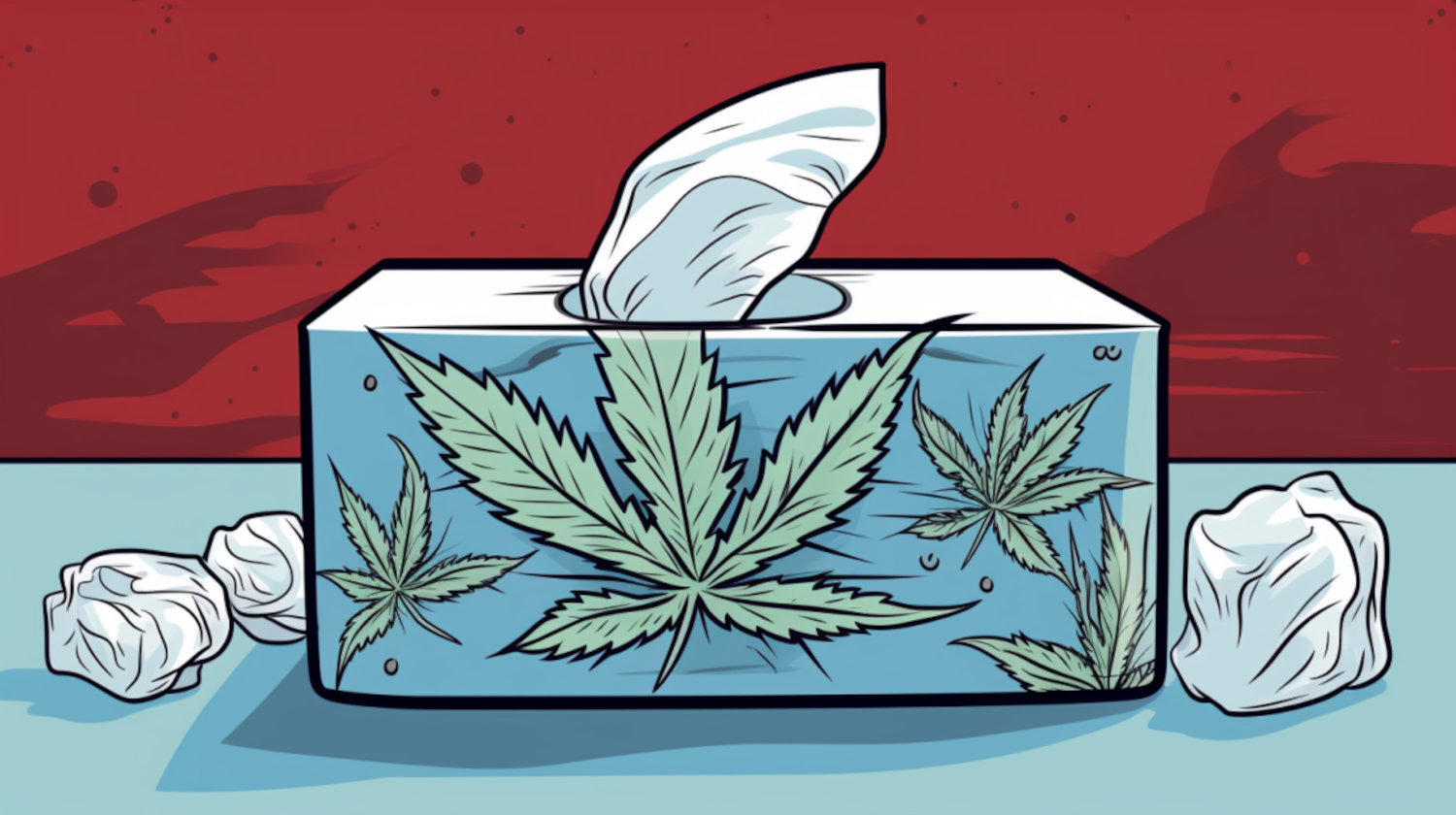In This Article
- What is Cannabinoid Hyperemesis Syndrome?
- What Causes Cannabis Hyperemesis Syndrome?
- Who Gets CHS?
- What are the Signs and Symptoms of CHS?
- What are the Phases of Cannabinoid Hyperemesis Syndrome?
- The Prodromal Phase:
- The Hyperemetic Phase:
- The Recovery Phase:
- What Are Cannabinoid Hyperemesis Syndrome Treatment Options?
- Pharmaceutical/Symptom Management of CHS
- Long-Term Behavioral Strategy for CHS Treatment
- Can Those with CHS Ever Use Cannabis Again?
- How Long Does It Take to Recover from Cannabinoid Hyperemesis Syndrome?
- Initial Treatment to Recovery: A Timeline
- Milestones in Recovery and Treatment Guidelines
- Cannabinoid Hyperemesis Syndrome Treatment Guidelines
- Is there a permanent cure, or is CHS a recurring condition?
- Can you still smoke marijuana if you have Cannabinoid Hyperemesis Syndrome?
- Can you smoke CBD if you have CHS?
- Is CHS a genetic condition?
- Are there methods for taking cannabis without worsening CHS?
- Can CHS cause death?
- Do hot baths work to alleviate CHS?
- How can I prevent CHS?
- Is acupuncture/acupressure really effective for treating CHS?
- References
Cannabis for both medical and adult use is on the rise. Many find cannabis an effective treatment for nausea and vomiting. Ironically, cannabis use is also the cause of a condition called Cannabinoid Hyperemesis Syndrome (CHS), where nausea and frequent vomiting are the primary symptoms.
Experts know that, usually, cannabis sends anti-nausea signals to the brain. But in rare cases, after continued and heavy cannabis use, signaling to the cannabis receptors in the digestive tract goes wrong and causes nausea and vomiting. Some researchers believe CHS may have a genetic origin. It just isn't clear exactly why some people get CHS and others do not. But, researchers do know only cannabis users get this condition.
The good news is that CHS is treatable and that full recovery is possible. However, the only complete "cure" comes from abstaining from cannabis. So, how long does it take to recover from cannabinoid hyperemesis syndrome?
What is Cannabinoid Hyperemesis Syndrome?
Cannabinoid Hyperemesis Syndrome, also known as Cannabis Hyperemesis Syndrome or CHS, is a medical condition caused by chronic, long-term cannabis use. CHS presents with an unwelcome mix of recurrent nausea, vomiting (emesis), and abdominal pain.1
What Causes Cannabis Hyperemesis Syndrome?
Scientists aren't sure why some people develop CHS. It may be caused by overstimulation of the CB1 receptors within the gut, a build-up of cannabinoid lipids in fat, or it may be brought on by a genetic factor that predisposes some people to this illness.1,2 Experts do know that only active cannabis users are diagnosed with CHS, and even then, most consumers won't ever experience it.
Who Gets CHS?
Individuals who have used cannabis at least weekly since adolescence seem most at risk. Symptoms of CHS don't appear for many months or even years after protracted heavy cannabis use. And not everyone who uses cannabis will develop CHS. Only about 32 out of 100,000 patients who come to the emergency room for nausea treatment are diagnosed with CHS.3 However, anyone using cannabis should be aware of the signs.
What are the Signs and Symptoms of CHS?

When CHS begins, the symptoms are mild and often mistakenly ignored or misdiagnosed. Before anchoring on the diagnosis of CHS, it is important to rule in or rule out other important diseases, considering the patient's age and other risk factors, many of which may require urgent surgical and medical management. Certainly, when discussing abdominal pain associated with nausea and vomiting, gastrointestinal conditions often leap to the forefront of one's mind, including:
- Gastritis
- Gastrointestinal reflux disease (GERD)
- Peptic ulcer disease (PUD)
- Appendicitis
- Diverticulitis
- Sigmoid volvulus
- Biliary colic
- Pancreatitis
- Nephrolithiasis
- Urinary tract infection
In female patients of reproductive age, additional diagnoses to consider include:
- Ectopic pregnancy
- Ovarian torsion
In older patients, especially those with hypertension, cardiovascular illnesses such as aortic pathology and atypical coronary artery syndromes may present as vague abdominal pain, nausea, and vomiting.
Once those are ruled out, it's time to consider the possibility of CHS seriously.
As it progresses, the cycle of nausea, vomiting, dehydration, diarrhea, and abdominal pain becomes more frequent, and patients may attempt to self-medicate. Some patients increase their cannabis use, believing the anti-emetic benefits it provides will ease their symptoms when, in fact, it will only increase them.
What are the Phases of Cannabinoid Hyperemesis Syndrome?

CHS develops slowly, sometimes over the years. It manifests in three distinct phases: the prodromal–or initial–phase, the hyperemetic phase, and the recovery phase.1
The Prodromal Phase:
Early warning signs emerge in this preliminary phase. Contact a healthcare provider or go to the ER for diagnosis.
Common symptoms and signs include:
- Mild abdominal discomfort
- Morning nausea
- Increased anxiety over vomiting
- May experience stomach issues from eating
- Unsuccessfully use more cannabis in an attempt to lessen nausea
- May cyclically continue for months or years
The Hyperemetic Phase:
Symptoms become more severe and debilitating in this hyper (excessive) emetic (vomiting) phase. Medical intervention now can prevent more severe complications.
Common symptoms in this phase include:
- Severe abdominal pain
- Intense, persistent nausea
- Vomiting, often multiple times per day
- Abdominal cramping
- Reduced food intake
- Weight loss, sometimes rapid
- Diarrhea
- Dehydration and dark urine
- Individuals might take hot showers or baths for symptom relief
- Symptoms will reoccur as long as cannabis is being used
The Recovery Phase:
Once the individual abstains from using cannabis, symptoms gradually decrease. Severe nausea subsides, and vomiting stops. Regular eating patterns resume, and weight stabilizes. The recovery speed may depend on the severity of physical trauma sustained through chronic vomiting and dehydration. Recovery continues as long as cannabis is not consumed.
- Cannabis use cessation occurs
- Nausea and vomiting decrease and stop
- Normal eating patterns resume
- Recovery continues while abstaining from cannabis
What Are Cannabinoid Hyperemesis Syndrome Treatment Options?

When it comes to Cannabinoid Hyperemesis Syndrome (CHS) treatment, it's essential to differentiate between controlling the symptoms and treating the actual condition. While various approaches can help manage the symptoms, the only known cure for CHS is to stop using cannabis.
Most sufferers report an unusual home treatment–taking long, hot showers or baths–temporarily alleviates these symptoms. However, with the underlying condition left untreated, CHS can cause serious medical issues.
Pharmaceutical/Symptom Management of CHS
Your healthcare provider may recommend pharmaceutical treatments, including over-the-counter (OTC) or prescription medicines for symptom management. Various medicines have been studied to see how well they control the symptoms of CHS, including:1
- Anti-emetic Medications: Prescription medications designed to combat nausea and vomiting. Medications may include ondansetron, metoclopramide, benzodiazepines, aprepitant or other medication. The effectiveness varies by individual.
- Capsaicin Cream: Over-the-counter (OTC) capsaicin cream, topically applied, has shown promising results in symptom control. It's thought capsaicin (an active component of chili peppers) interacts with the body's pain receptors, helping reduce abdominal discomfort.
- Antihistamines: OTC antihistamines may work to block nausea signals from the brain.
- Analgesics: These are pain-relieving medications. Nonsteroidal anti-inflammatory drugs (NSAIDs), such as ibuprofen, may be used to manage the abdominal pain associated with CHS.
- Haloperidol or Droperidol: Antipsychotic medications have been used successfully to block the dopamine receptors in the brain, decreasing nausea and vomiting.
Long-Term Behavioral Strategy for CHS Treatment
The most effective treatment for cannabinoid hyperemesis syndrome is complete abstinence from cannabis. Medications and topical treatments offer only short-term relief. If quitting cannabis on your own is difficult, medical professionals can help with behavioral and medical approaches to assist in the treatment and long-term strategies for eliminating CHS.4
Can Those with CHS Ever Use Cannabis Again?
Although the medical community is unified on cessation as the only option for those with CHS, some anecdotal reports claim that by using lower THC products or consuming less, cannabinoid hyperemesis syndrome can be avoided. Still, others fault cannabis products themselves, suggesting that excessive THC or commercial pesticides might trigger the condition.
However, health professionals warn that given the recurrent nature of CHS, even moderate cannabis use may trigger a relapse, leading to the return of debilitating symptoms. No clinical studies have shown a successful alternative to complete abstinence for permanent relief from cannabis hyperemesis syndrome.
How Long Does It Take to Recover from Cannabinoid Hyperemesis Syndrome?
The good news is the recovery process from CHS begins when cannabis use ceases, but it's not an overnight cure. Every person will have their own experience, but the process typically follows a standard timeline.
Initial Treatment to Recovery: A Timeline
The first step to recovery is the cessation of cannabis use. Meeting with a healthcare provider can ease the recovery process. A combination of prescribed pharmaceuticals and OTC pain relievers used as recommended can manage symptoms.1 With continued abstinence and symptom management, full recovery can follow.
Milestones in Recovery and Treatment Guidelines
Phase 1: Cessation of Cannabis Use
This is the first and most crucial step in the recovery process. Once cannabis use is stopped, the symptoms of CHS will gradually start to subside.
Tips to stop using cannabis:
- Commit to Abstinence. The most effective strategy for treating CHS is complete cessation of cannabis use. Without cannabis use, CHS will not reoccur.
- Consult a Healthcare Professional. Get medical help if needed to stop using cannabis and to obtain medical treatment.
- Mental Health Support. Given the potential psychological impact of CHS and the challenge of cannabis cessation, consider seeking support from a mental health professional. Counseling or support groups can be a valuable resource.
Phase 2: Symptom Relief
Over the weeks following the cessation of cannabis use, individuals will start to notice a reduction in the severity and frequency of their symptoms.
Tips to aid in symptom relief from CHS:
- Follow Medical Advice. Regular check-ins with your doctor or a healthcare provider are essential. They can monitor progress, adjust treatments as necessary, and provide ongoing support. Use prescription and OTC medications as directed by a healthcare provider.
- Stay Hydrated: Severe dehydration can be a significant concern with CHS due to recurrent vomiting. Therefore, it's crucial to replenish fluids regularly, even if only in small amounts at a time.
- Opt for Bland Foods. During the recovery period, opt for a bland diet to minimize the stress on the digestive system. Foods like rice, bananas, applesauce, and toast—often called the BRAT diet—can be easier to tolerate.
Phase 3: Full Recovery
Full recovery, marked by the complete absence of CHS symptoms, can take several weeks or even months after stopping cannabis use.
Tips to maintain an absence of CHS symptoms:
- Maintain Contact with a Support Team. After the symptoms have subsided and you feel better, stay on top of your health with regular check-ups. Be sure to let your support team or doctor know if you are struggling.
Phase 4: Relapse
If cannabis use is resumed, symptoms of CHS can return, often heralding a return of the hyperemesis many weeks or months later.
Tips to avoid a relapse:
- Reach out for Help. If you return to cannabis use and experience CHS symptoms, contact your healthcare provider before the condition becomes severe. They can help with getting your process back on track.
Cannabinoid Hyperemesis Syndrome Treatment Guidelines

When recovering from cannabinoid hyperemesis syndrome, it's wise to avoid anything that could potentially exacerbate symptoms or slow recovery. Skip foods and beverages that irritate the stomach, such as alcohol, caffeine, and spicy foods. Also, avoid stressful situations as much as possible, as stress can sometimes worsen CHS symptoms.
It's important to note that each individual's recovery timeline can vary; some may recover faster or slower than others. The key to recovery is the complete cessation of cannabis use and supportive care to manage symptoms.1 Recovery from CHS can be challenging, but remembering these guidelines can make the process less arduous. Patience, self-care, and professional guidance can make a significant difference in regaining health and wellness.
Is there a permanent cure, or is CHS a recurring condition?
The only known permanent cure for Cannabinoid Hyperemesis Syndrome (CHS) is complete abstinence from cannabis. If cannabis use is resumed, CHS can recur.
Can you still smoke marijuana if you have Cannabinoid Hyperemesis Syndrome?
No, continuing to use cannabis in any form can exacerbate the symptoms of CHS and delay recovery. The most effective treatment for CHS is to stop using cannabis.
Can you smoke CBD if you have CHS?
CBD is not thought to interact the same way as THC to cause a CHS episode, and many consumers find symptom relief when using CBD. However, it is best to consult with your doctor first before introducing CBD.
Is CHS a genetic condition?
Some researchers believe there may be a genetic component in CHS development. The authors encouraged further genetic studies and research into CHS as a genetic disease unmasked by excessive THC exposure.2
Are there methods for taking cannabis without worsening CHS?
Generally, no. To prevent worsening CHS symptoms, medical advice suggests complete cessation of all cannabis usage.
Can CHS cause death?
If not adequately managed, CHS can lead to severe complications like dehydration, brain swelling, esophageal tears (Mallory Weiss tear), electrolyte imbalances, kidney failure, and, in severe cases, death. However, these are preventable with proper treatment.
Do hot baths work to alleviate CHS?
Hot baths or showers may temporarily relieve symptoms, but they are not a long-term solution for CHS.
How can I prevent CHS?
The most effective way to prevent CHS is to avoid chronic use of cannabis.
Is acupuncture/acupressure really effective for treating CHS?
Acupuncture/acupressure has been used to treat nausea symptoms successfully. However, there have been no specific studies for this alternative practice in treating CHS.
References
- Rubio-Tapia A, McCallum R, Camilleri M. AGA Clinical Practice Update on Diagnosis and Management of Cannabinoid Hyperemesis Syndrome: Commentary. Gastroenterology. 2024;166(5):930-934.e1. doi:https://doi.org/10.1053/j.gastro.2024.01.040
↩︎ - Russo EB, Spooner C, May L, Leslie R, Whiteley VL. Cannabinoid Hyperemesis Syndrome Survey and Genomic Investigation. Cannabis and Cannabinoid Research. 2021;7(3). doi:https://doi.org/10.1089/can.2021.0046
↩︎ - Andrews CN, Rehak R, Woo M, et al. Cannabinoid hyperemesis syndrome in North America: evaluation of health burden and treatment prevalence. Aliment Pharmacol Ther. 2022;56(11-12):1532-1542. doi:10.1111/apt.17265
↩︎ - DeVuono MV, Parker LA. Cannabinoid Hyperemesis Syndrome: A Review of Potential Mechanisms. Cannabis Cannabinoid Res. 2020;5(2):132-144. Published 2020 Jun 5. doi:10.1089/can.2019.0059
↩︎
The information in this article and any included images or charts are for educational purposes only. This information is neither a substitute for, nor does it replace, professional legal advice or medical advice, diagnosis, or treatment. If you have any concerns or questions about laws, regulations, or your health, you should always consult with an attorney, physician or other licensed professional.




